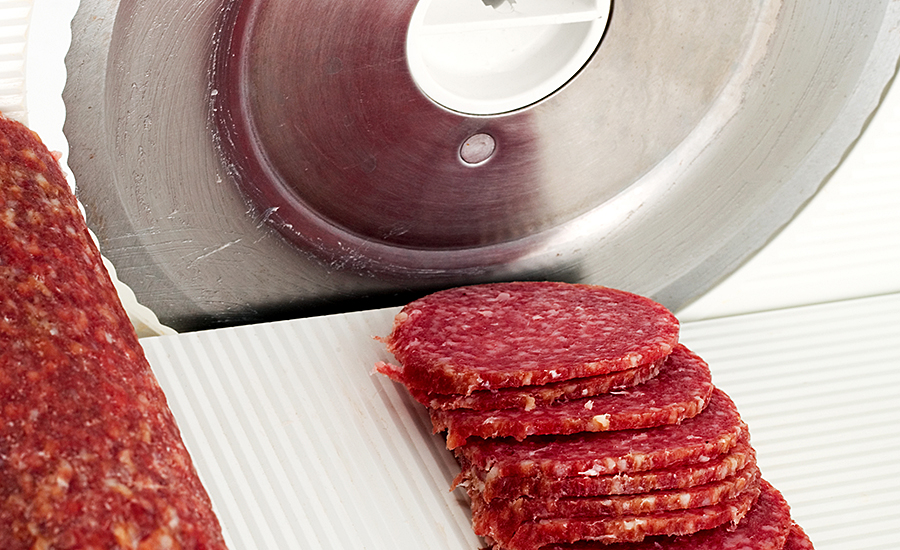Operating band saws, knives and slicing and dicing equipment requires a sharp focus if meat- and poultry-processing workers are to be safe and productive. But plant operators must focus on minimizing risks rather than expecting to eradicate all incidents, analysts say. When injuries happen, a leading cause is worker complacency, which often results from repeating the same cutting movements, he says.
“It becomes almost robotic in nature,” says Gregg Rentfrow, associate extension professor and meat science specialist in the Department of Animal and Food Sciences at the University of Kentucky in Lexington. “Workers’ minds are elsewhere and they may not be paying attention to their knives or where their hands are. You can get bit when taking things for granted.”
In addition to the prospects of cuts and lacerations, workers risk amputations when cleaning machinery containing sharp blades by not adequately following lock-out, tag-out procedures, says Shawn Lynn, director of environmental health and safety for Land O’Frost.
Employees also face ergonomic hazards from applying force or being in awkward positions when using a knife or loading logs onto slicing machines, he says.
Worker fatigue is another major cause of injuries, says Chris Fuller, owner and operator of Fuller Consulting, a San Diego-based small-meat-processor consulting firm.
“Equipment generally is safe to operate by following the proper procedures and having the safety mechanisms working and in place per manufacturer specifications,” he says. “Injuries, whether from cutting, crushing or straining, are often due to the equipment operator losing focus from working long hours and ignoring or misunderstanding safety protocols.”
Rentfrow agrees that employee exhaustion, resulting in part from a failure to take breaks or operating when ill, can be troublesome.
“Workers can do stupid things when they get tired and are not thinking straight,” he says. “Sometimes they just need to relax and recover their energy. Not feeling 100 percent increases the opportunity to get hurt.”
Make protective equipment a priority
Regardless of their mental or physical state, it is crucial for workers to wear the most appropriate safety apparel if they are to reduce injury risks.
Such gear can include steel mesh and Kevlar gloves, steel mesh aprons, plastic forearm shields and heavy gut guards that protect the midsection, Rentfrow says. He says, however, that discomfort may make workers reluctant to use the necessary personal protective equipment.
“Gear can be cumbersome,” Rentfrow says. “Thick heavy guards can impede movement and steel mesh aprons are very heavy and fill up with fat. Some workers must rinse and clean the items and then put on wet gear, which may be very uncomfortable in a cold environment.”
The optimal protective equipment, meanwhile, will vary by job. Simple cutting may just require gloves, while more intricate movements can necessitate steel mesh aprons, he says, adding some workers only use gloves that protect the thumb, index and middle fingers because those are the body parts that get cut most frequently.
Land O’Frost issues cut-resistant gloves to employees who frequently use knives or are exposed to sharp objects, Lynn says.
“We find appropriate gloves that can be worn all day and make it standard wear so that staffers do not have to remember to put on the items when performing a certain task or job,” he says.
Yet, wearing protective gear does not guarantee safety, particularly because there may be gaps in between the different apparel, such as the space separating steel mesh gloves and protective sleeves, Rentfrow says.
“Accidents happen and we can’t make everything 100 percent effective,” he says.
Instruction is of the essence
Proper and repetitive training and enforcement can greatly help reduce mishaps, analysts say.
Land O’Frost provides general knife safety training to relevant employees, which can include reminders to cut in a direction away from their bodies when slicing meats, instructions for storing knives and other cutting tools properly and demonstrating the importance of only using knives or blades for their intended purposes and keeping the tools sharp, Lynn says.
Workers also undergo lock out, tag out instruction to ensure they don’t expose themselves to injury when removing or bypassing safety guards. They also learn why it is vital to be cautious when using cutting machinery, he says.
All meat and poultry plants benefit from routinely holding safety classes and addressing all potential dangers and risks, Fuller says.
“Staff training is essential for understanding how to operate a machine securely and what to watch for if an unsafe circumstance presents itself,” he says. “Instructing on proper equipment maintenance will help keep cutting machines running safely and ensures that safety switches and other mechanisms stay operable to avoid injuries.”
That is crucial because slicing machine blades and knives are the most hazardous instruments in Land O’Frost plants, he says.

Create a constant safety mindset
To further enhance safety, the company looks for machines that reduce or eliminate cutting logs and employee exposure to slicer blades, as well as equipment with extra safety interlocks and sensors, Lynn says.
“Employers should audit potential equipment to make sure it meets their standards for safe design,” he says, noting that Land O’Lakes also performs cutting tool assessments to identify the safest equipment for specific processes.
In addition, by tracking “near miss” incidents, Land O’Frost can better identify injury trends within specific areas of facilities and respond accordingly, Lynn says.
“Analyzing potential incidents helps identify where facility management needs to focus so they can eliminate or reduce hazards,” he says, adding that processors also should periodically audit their cutting processes to ensure workers are following administrative controls and policies.
Yet, having employees always follow safety protocols can be difficult in a fast-paced meat-processing environment, Fuller says.
“Operators should encourage safe behavior and reiterate to their staff that although production schedules must be met, safety is a top concern,” he says. “A safe workplace is an efficient and profitable workplace.”
Processors can foster a safety culture by rewarding proper behavior and investing in appropriate machine maintenance to help reduce injuries from mechanical issues, Fuller says.
“Assigning a safety champion or having regular safety roundtables demonstrates to workers that safety is a priority and that the employer takes it very seriously,” he says.
All stakeholders, meanwhile, must understand the benefits of a secure cutting environment, Lynn says.
“Senior leaders when discussing capital projects should know why it is necessary to have equipment that protects employees from hazards,” he says, noting that such gear also results in lower operating costs and less downtime.”
It also is important to properly communicate to workers why the company is making safety-oriented changes to personal protective equipment or policies so there is buy-in, Lynn says. “Employees are then more willing to coach colleagues on the alterations and the need to perform tasks differently,” he says.
Land O’Lakes even involves workers when developing safety measures, Lynn says, which includes brainstorming sessions on ergonomic issues to identify the common postures or forces workers encounter when operating cutting, slicing and dicing equipment and determining how to make the procedures less stressful.
A wide range of potential pitfalls
It is also vital for workers to be able to properly treat cut victims, Rentfrow says. They need to wear latex gloves to protect themselves from possible blood-borne diseases and avoid the use of adhesive bandages, which could inadvertently mix with meat and poultry and end up in packages.
Yet, regardless of the safety actions, hazards remain ever-present. Rentfrow says less common but still menacing risks include workers getting caught and possibly crushed on the cutting machineries’ hydraulic parts if they are unable to engage the safety shutoff, band-saw blades grabbing hold of the rings on employees’ steel mesh gloves and workers being cut by colleagues who are slicing meats in close proximity.
Lacerations also can occur when workers fumble with a knife and try to catch the tool before it hits the ground or grab meat from cutting blocks without checking for a knife hidden under the product, Rentfrow says.
“It is extremely important to always maintain situational awareness,” he says. NP




